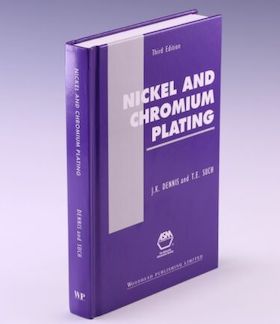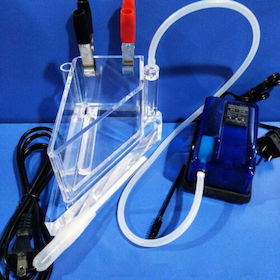
-----
Nickel Sulfamate Plating Bath pH Adjustments
Q. We are a small Nickel plating workshop here in Bangalore India and have a problem for which we need your help.
We do peroxide treatment for removal of Iron. For this we bring to pH to 5 to 5.5 using Nickel Carbonate and then add small quantities of peroxide. We find that increasing the pH to 5 and above using Nickel Carbonate rather difficult and friends have suggested using Sodium Hydroxide instead.
But we thought Sodium in the solution causes brittleness? But these friends say that this is not true and the bath can tolerate substantial amount of Sodium and they have been using NaOH for a large number of years without any deleterious effects.
Can you please clarify? What is the tolerance of the bath for Sodium?
Regards,
Jayant KamathAries Industries - Bangalore, Karnataka, India
2001
A. First, the problem is with adding the NaOH. It is very strong and forms a nickel hydroxide, a nasty little gel ball, that takes a long time to redissolve. By using a weak solution, you add a lot of liquid to the tank that must be decanted or evaporated.
Eventually, an excess of sodium ions is going to affect the plating or the plate rate. The type and amount of other tramp ions will determine the point at which it is a problem of consequence.
James Watts- Navarre, Florida
2001
Ed. note: Closely related threads include --
- letter 18923, "Why is pH is dropping/decreasing in nickel sulfamate plating bath?"
- letter 18637, "Nickel sulfamate pH is too low. How to raise?"
Alternative to nickel carbonate for raising pH?
Q. Is there anything that can be safely added to a nickel sulfamate bath to increase the pH other than nickel carbonate? It is very rare that we need to increase the pH, but when we do raise it we use nickel carbonate and have run into several problems.
First, it is very unpredictable. It takes such a long time to dissolve that our lab techs inadvertently overdose our baths. Once the baths have been overdosed we typically spend a day or two fighting to restabilize the pH. Sulfamic acid is added to bring the pH back down, more of the excess nickel carbonate dissolves causing the pH to go out of spec, we add more sulfamic acid, and so on.
Second, nickel carbonate is extremely difficult to handle. There is so much dust associated with it that the technicians do not want to use it.
It was suggested that we use sodium hydroxide to increase the pH. Are there any negative side effects? Does the sodium co-deposit with the nickel? Is there anything else that can be used to increase the pH?
- Rock Hill, South Carolina
2001
A. A properly operated sulfamate bath will never need the pH raised unless you are trying to precipitate the iron out. Solution is to not let the iron get in.
Nickel carbonate is just plain nasty and dust is one of the lesser problems. It also normally contains nickel oxide to reduce the clumping. This is a particle and will co deposit in the nickel making it look like it was related to a porcupine. Any pH up adjustment should be done in another tank and then filtered back into the plating tank. I have seen the carbonate put into an anode bag and solution pumped into the bag which was in a small tank that overflowed into the main tank. Every few minutes the bag had to be kneaded as it was now a giant gel ball. Granted it is slow, but it does not get away from you.
Your over-correction problem is the boric acid buffer. It has 3 buffering pH's. As it approaches one, it resists as much as it can to changing the pH. That is what you put it in for. When that step is overcome, the pH rises rapidly because of the frustration caused excesses.
Next, pH is logarithmic. It takes a lot less to change it from 4.0 to 4.1 than it did to change it from 3.9 to 4.0, and vice versa going the other way.
Management decision time: train the operators and give them enough time to do it correctly, or take two days chasing your tail getting further behind by the hour and wasting chemicals.
- Navarre, Florida
2001
A. Raising pH with carbonate or hydroxide is nasty. The easiest way to do it is by plating dummy parts for a day. The pH will rise automatically.

Sara Michaeli
Tel-Aviv-Yafo, Israel
2001
A. Yes Sara,
But at the same time, be prepared to waste electricity, metal, other chemicals plus valuable time of 1 day production. I think it is inappropriate. Best thing is as James suggested, not to let it go out of order first of all ... or second if it does go up, add Nickel carbonate in an off line tank, mix it and pump it.

Hemant Kumar
- Florida, USA
2001
A. There are various types of nickel carbonate, dry and prewetted. The prewetted material dissolves much faster without dusting.
Also you should pack a filter with the NiCO3 and run the solution through the filter to raise the pH. Add a known amount of material, little first to see how much the pH is raised and keep notes.

George Shahin
Atotech - Rock Hill, South Carolina
2001
A. How low is the pH getting that you want to bring it up chemically? Nickel sulfamate operates @ pH 3.6-4.4. Why is it getting out of range? Dummy plating is the safest way.
Deidre Feeley- Colorado Springs, Colorado, USA
2001
A. Make sure that your boric acid is saturated. If your boric acid is low then the bath will be susceptible to pH swings.
Russell Richter- Danbury, Connecticut, USA
2001
A. It was not stated if the pH drop was an expected result of the process design, and I agree with the other respondents that raising the pH is seldom required with a normally operated nickel sulfamate process.
However, I have had to use nickel carbonate to adjust pH and nickel metal at the same time with a high speed sulfamate nickel and an inert anode, high speed process. I used a horizontal plate filter (Mefiag) packed with Nickel carbonate and a filter aid (to reduce filter plugging). This system was controlled by an in-tank pH meter and successfully replenished the metal (and controlled pH drop) with little problems and almost no manual intervention.
- Fountain Inn, South Carolina
2001
2002
Q. John,
I was just wondering if you managed to control the iron in your nickel bath by adjusting pH using nickel carbonate. Believe it or not I'm being challenged with the same problem as yours; so don't feel too bad about it.
In the lab I tried to mix NiCO3 in nickel plating solution and it just did not happen! I heated the solution to about 50 °C and still no improvement.
I think there is a specific type of NiCO3 that dissolves better and faster.
I'm going back to the old/usual method of dummying until someone comes up with a method (tested and tried and worked) that actually works! It sounds like an awfully simple chemistry problem, but I'm not a chemist to judge!
Any comments or suggestions will be appreciated.
Electroplating - AB, California
A. Your chemical must be some other chemical. The very fine nickel carbonate that we used in our shops and laboratory would fizz and react instantly.
Die Castings, 1934, by Herbert Chase,John Wiley, New York, page 234, says that you can prepare "fresh" basic nickel carbonate by adding 1 part of sodium carbonate
⇦ on
eBay or
Amazon]
to 7 parts of nickel sulphate in just sufficient water to dissolve the nickel sulphate. I will try this next chance I get, but the idea of a "fresh" preparation may lend credence to the problem experienced by the last reader who had trouble making the carbonate react.

Tom Pullizzi
Falls Township, Pennsylvania
2002
A. Easy, use magnesium carbonate.
Dan Mullen- Greeneville, Tennessee, USA
December 19, 2008
Multiple threads merged: please forgive chronology errors and repetition 🙂
How to calculate sulphamic acid addition to lower pH in nickel sulfamate tank?
Q. I have a nickel sulfamate solution tank (approx. 60 gallons) that I use for nickel plating 45 rpm record stampers ... the pH is approx. 5.2. I need to know how much sulfamic acid to add to my tank to get the pH down around 3.8-4.0
Tom DillanderPalomino Records - Shepherdsville, Kentucky, USA
2005
A. You're going to have to determine that empirically. Take one liter of bath on a hot plate, measure the pH with a meter with ATC, and slowly make known additions of sulfamic acid with stirring until the pH is where you want it. Then scale the addition to your bath volume. The bath pH depends on other factors than just volume, so I can't just give you a number of ounces/pounds of acid to add.

James Totter, CEF
- Tallahassee, Florida
2005
A. That will depend a lot on how much boric acid that you have in the tank. I assume that it is nearly saturated. 5.2 pH is about where the last H is in boric acid, so you will have to overcome that before the pH starts to drop. Then it will drop like a rock to about 4 to 4.2 and will again take a given amount to overcome the middle H in boric and then it will again drop like a rock.
From practical experience, dissolve about 100 mL of sulfamic acid in about 500 mL of warm plating solution and add to the tank with good agitation, Rinse the beaker. Wait 1 hour and sample the tank again for pH. Repeat as many times as required. DO not get in a rush or you WILL overshoot 3.8 by a bunch and then you will have to use nickel carbonate to raise the pH and trust me, you do not want to do that if you can possibly avoid it. The reason for waiting is for the boric acid buffer to reach equilibrium and have a stable pH.
James Watts- Navarre, Florida
2005
A. I cannot tell you how much sulphamic acid to use, but what I would suggest is that you make up a gallon or so of 20% sulfamic acid ⇦ on eBay or Amazon [affil link] and slowly add some of it to the bath until the pH has been reduced to 3.8-4.0. I would expect the volume added to be in the region of 100-200 mls, but don't take that as gospel. Be careful adding it because there can be a delay between the addition and the pH stabilising. As you use the bath, you will notice the pH naturally rises, so you will need to make regular additions and sulphamic acid doesn't "go off" so the solution will not be wasted. Be careful with sulphamic acid - it is a very strong acid.

Trevor Crichton
R&D practical scientist
Chesham, Bucks, UK
2005
A. Sulfamic acid is a weak acid with a relatively low dissociation constant. Even if it is a simple pH calculation to find the necessary amount, it is more convenient to add progressively small amounts of sulfamic acid and after each addition take pH measurement with a pH meter until you reach the desired pH value. But please note that after each addition you should agitate the solution for 15-20 min in order to have all sulfamic acid dissociated in the tank.
C. BIYIKLI- Turkey
2005
A. Dear Tom
I am giving am amount of sulfuric acid to reduced pH from 5.2 to 3.8 is 21.2 ml/100 ltrs I think this is helping you.
- Mumbai, Maharashtra, India
2005
A. I suggest you make up some sulfamic acid ⇦ on eBay or Amazon [affil link] solution and slowly add it to the tank until you get the correct pH. Take note that the change in pH takes some time to settle down, so be careful with the additions. If you don't just get on and do it, you will end up in a situation where you are debating how many fairies fit on the end of a needle.

Trevor Crichton
R&D practical scientist
Chesham, Bucks, UK
2005
A. In our nickel plating baths (30 gallon) we have found that the pH adjusts by 0.2 for a 30 gram addition of sulfamic acid. Therefore, for a 60 gallon bath, you would need to add 360 grams sulfamic acid to adjust the pH from 5.2 to 4.0.
Bethany Hagan- Wenatchee, Washington, USA
2005
Sorry, but it is not a simple as Bethany puts it. First, pH is logarithmic, so it depends greatly what the starting pH is. It takes ten times as much to go from 4.2 to 4.0 as it takes to go from 5.2 to 5.0.
Second, it depends greatly on how much boric acid there is and if it is saturated, what the temperature is.
- Navarre, Florida
2005
Bethany is right assuming boric, Ni, and all additives are at optimum.
Joe Miller- Tennessee
2005
Bethany may be correct in the amount, but not the way she stated it. pH is logarithmic!
James Watts- Navarre, Florida
2005
A. And after all these replies, go back to the very first reply. Simple, sensible and saves any dangers of over- or under- adjustment.
Brian TerryAerospace - Yeovil, Somerset, UK
2005
![]() Thanks to Jim Totter for the original answer and to Brian for re-emphasizing it in closing out! I can't tell you how many times we've received inquiries running something like this --
Thanks to Jim Totter for the original answer and to Brian for re-emphasizing it in closing out! I can't tell you how many times we've received inquiries running something like this --
"I had 20,000 gallons of zinc-contaminated pH6 waste. So I added 200 gallons of caustic sodato raise the pH to 10, but too much zinc remained. So I read that you need to lower the pH to 3.5 first and add a co-precipitant. So I added 350 gallons of sulfuric acid and 200 gallons of ferric sulphate. Then I added another 500 gallons of caustic to raise the pH back to 10 again, but I overshot, and the pH is 11.5. Before I add more acid, I wanted to ask ..." :-)
Folks, listen to Jim and Brian -- that's NOT how you do it! You don't work on the whole batch based on theory ... you work with a beaker [beakers on
eBay
or
Amazon [affil link] or so, determine exactly what works and how much to add, and THEN SCALE UP. Good luck.
Regards,

Ted Mooney, P.E.
Striving to live Aloha
finishing.com - Pine Beach, New Jersey
Ted is available for instant help
or longer-term assistance.
October 2013
Is hydrogen peroxide treatment of nickel plating solutions always necessary?
Q. If I start with chemicals from Sigma-Aldrich and Alfa Aeser, how necessary is it to use a hydrogen peroxide and high pH treatment of my solution to precipitate iron?
I just ran into the problem of having issues dissolving nickel carbonate. I add it and it takes a long time for it to completely dissolve and alter the pH. Am I wasting my time with these steps?
I'm only doing it because I've seen literature [deleted by editor; see Ted's reply] that makes it seem necessary for any bath.
- Cambridge, Massachusetts, USA
July 18, 2014
A. Hi Juan. You may know this already, but in case you or another reader isn't aware of it, it's conventional to buy plating chemistry from plating process providers rather than from analytical chemical suppliers. When you do so, you get the advantage of their knowledge & experience, their technical data sheets to know how to best operate the process, and lab analysis help when you need it. Depending on the particular plating process, the chemistry may include proprietary ingredients like brighteners and wetting agents that improve the operation. This is not to say that a nickel sulphamate bath cannot be a home-brew affair though.
The source of the iron which must be removed is not impurities in the chemicals used; rather, it comes from the parts being plated. In a production situation, acid activation before plating may drag some dissolved iron into the bath, the parts may slightly dissolve in the acidic plating solution, and sometimes a part even falls off the plating rack and sits there dissolving at the bottom of the plating tank. If you are doing a lab experiment with fresh analytically pure chemicals, I doubt that hydrogen peroxide treatment or any other purification will be required.
Note: your inquiry included a link to a 36-page article, George DiBari's "Electrodeposition of Nickel", which comprised Chapter 3 of a plating textbook (I don't know which one). That article was originally captured from a Pirate Bay torrent, and I don't know whether the copyright on the unknown book has expired or not. I realize that some people feel that "all knowledge should be free"; I don't want to debate the point here, nor be self-righteous, just to mention that we don't link to on-line versions of such works when we question their legal status.
Good luck!
Regards,

Ted Mooney, P.E.
Striving to live Aloha
finishing.com - Pine Beach, New Jersey
Ted is available for instant help
or longer-term assistance.
July 2014
Some nickel plated parts bright; other shapes not
Q. Hello,
May I ask: we process two metals in same nickel bath but one of them is bright (cylindrical) other one is (smooth) dull. What might make the difference? pH might cause this? And the metal which has been polished is the dull one. I need help. Thank you.
kalekilit - istanbul TURKEY
October 11, 2018
A. Hi Yunus. Plating is somewhat complex, with a lot of variables ... so you need to provide a fair amount of data if you want anything beyond wild guesses.
You are doing sulfamate nickel plating on what (steel?). Why would you expect the pH to vary when you are doing one type of part from when you are doing the other type? My own first guess is that the dull parts have a greater total surface area so you are plating at a lower current density which is not bringing out brightness. Have you done any Hull Cell ⇦ huh? tests? What is the bright plating range? Do areas of the Hull Cell resemble your two components in brightness?
Regards,

Ted Mooney, P.E. RET
Striving to live Aloha
finishing.com - Pine Beach, New Jersey
Ted is available for instant help
or longer-term assistance.
adv.

"The Sulfamate Nickel How-To Guide"
by David Crotty, PhD
& Robert Probert
published Oct. 2018
$89 plus shipping
Q, A, or Comment on THIS thread -or- Start a NEW Thread

